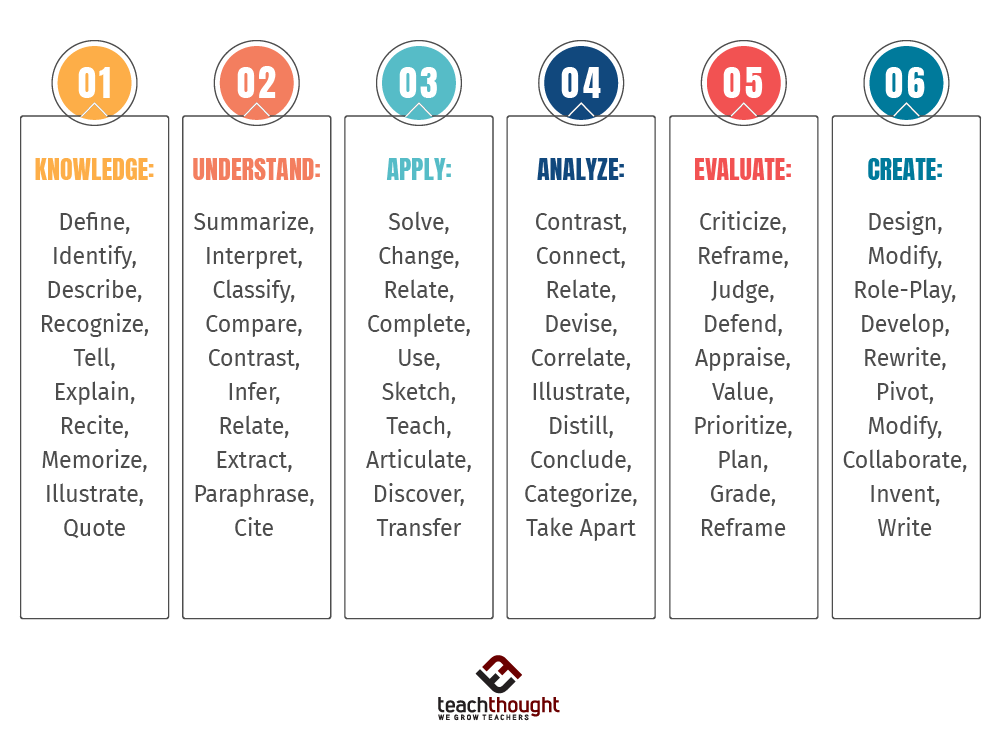100+ Bloom’s Taxonomy Verbs For Critical Thinking
Bloom’s Taxonomy verbs include Evaluate: Criticize, Judge, Defend, Appraise, Value, Prioritize, Revise, Argue, Support, and Re-design.

Bloom’s Taxonomy Verbs For Critical Thinking
by TeachThought Staff
Bloom’s Taxonomy’s verbs–also known as power verbs or thinking verbs–are extraordinarily powerful instructional planning tools.
In fact, in addition to concepts like backward design and power standards, they are one of the most useful tools a teacher-as-learning-designer has access to. Why?
As research has suggested, they can be used for assessment design, curriculum design, lesson planning, personalizing and differentiating learning, and almost any other ‘thing’ a teacher–or student–has to do.
For example, if a standard asks students to infer and demonstrate an author’s position using evidence from the text, there’s a lot built into that kind of task. First, a student has to be able to define what an ‘author’s position’ is and what ‘evidence from the text’ means (Knowledge-level). They’ll then need to be able to summarize that same text (Understanding-level), interpret and infer any arguments or positions (Analyze-level), evaluate inherent claims (Evaluate-level), and then write (Create-level) a response that demonstrates their thinking.
Though the chart below reads left to right, it’s ideal to imagine it as a kind of incline, with Knowledge at the bottom, and Create at the top. You may not always need this kind of tool to ‘unpack’ standards and identify a possible learning sequence, but it also works ideally as an assessment design tool. If students can consistently work with the topic in the columns to the right–designing, recommending, differentiating, comparing and contrasting, and so on, then they likely have a firm grasp on the material.
You can also read more about Bloom’s Revised Taxonomy (or Bloom’s updated Taxonomy) if you’re so inclined.
While we’ve shared Bloom’s Taxonomy posters before, the simplicity and clean design of the chart format make it a bit more functional–even useful to hand to the students themselves as a hole-punch-and-keep-it-in-your-journal-for-the-year kind of resource. It also makes a powerful self-directed learning tool. Start at the left, and, roughly, move right.
Also see Bloom’s Digital Verbs For Technology-Rich Teaching for a version of Bloom’s designed for digital tasks and tools.
For a visual version of this framework, see Bloom’s Digital Taxonomy Chart.
Knowledge: Define, Identify, Describe, Recognize, Tell, Explain, Recite, Memorize, Illustrate, Quote, State, Match, Recognize, Select, Examine, Locate, Recite, Enumerate, Record, List, Quote, Label
Understand: Summarize, Interpret, Classify, Compare, Contrast, Infer, Relate, Extract, Paraphrase, Cite, Discuss, Distinguish, Delineate, Extend, Predict, Indicate, Translate, Inquire, Associate, Explore Convert
Apply: Solve, Change, Relate, Complete, Use, Sketch, Teach, Articulate, Discover, Transfer, Show, Demonstrate, Involve, Dramatize, Produce, Report, Act, Respond, Administer, Actuate, Prepare, Manipulate
Analyze: Contrast, Connect, Relate, Devise, Correlate, Illustrate, Distill, Conclude, Categorize, Take Apart, Problem-Solve, Differentiate, Deduce, Conclude, Devise, Subdivide, Calculate, Order, Adapt
Evaluate: Criticize, Reframe, Judge, Defend, Appraise, Value, Prioritize Plan, Grade, Reframe, Revise, Refine, Grade, Argue, Support, Evolve, Decide, Re-design, Pivot
Create: Design, Modify, Role-Play, Develop, Rewrite, Pivot, Modify, Collaborate, Invent, Write, Formulate, Invent, Imagine
100+ Bloom’s Taxonomy Verbs For Critical Thinking
